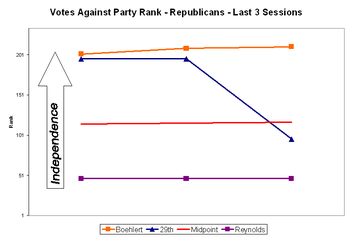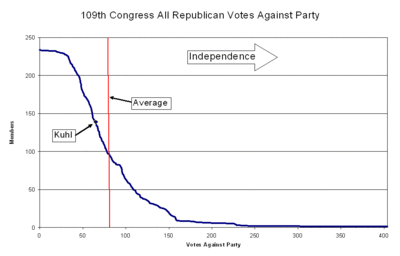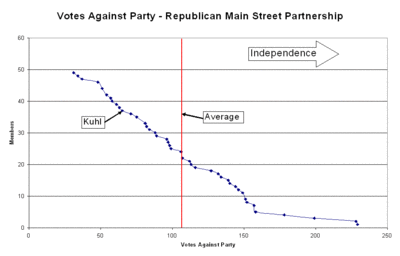Analysis
Perils of the Bring Home the Bacon Strategy
Fri, 09/29/2006 - 11:09 — RottenchesterRandy Kuhl is in a little bit of hot water with the UAW, who say that he took too much credit for bringing federal money to the proposed Sikorsky/Schweizer helicopter plant in Big Flats, near Corning. Apparently, a Kuhl ad running in the Southern part of the 29th claims that Randy brought more than 100 jobs to the district.
I haven't seen the ad, and it isn't online, Here's the ad. Like Kuhl's other money ad, it sure leaves the impression that he played a big part in bringing some bacon home to the district. That's stretching it, because, as a freshman, Kuhl's role in long-term funding projects that have been in the hopper for years is peripheral at best.
But a little over-reaching isn't the only trouble with Kuhl's money-centric strategy. Even if you buy the dubious premise that Kuhl was personally responsible for bringing extra money into the district, you have to recognize that it was Kuhl's party loyalty and inside party contacts that put him in a position to earmark bucks for the 29th. Since it looks like the Republicans might lose their majority in Congress, a vote for Randy Kuhl on the basis of money alone is a risky one. He might well be a loyal member of the opposition if he's re-elected, and that means fewer (or no) earmarks. If you're on the fence, I don't see money alone pushing you into the Kuhl camp.
Kuhl vs Houghton on Independence
Thu, 09/21/2006 - 22:12 — RottenchesterAmo Houghton, the previous holder of the 29th's seat in Congress, is considered an independent, centrist Republican. He voted against the war in Iraq and was one of the founders of the centrist Republican Main Street Partership. Let's compare his voting record with self-proclaimed "Independent" Randy Kuhl.
Using data from the last three sessions of Congress, I ranked Kuhl and Houghton against their peers in the Republican party on a simple independence metric: the number of times that each voted against the majority of their party.
In the 108th and 107th Congress, Amo Houghton voted against his party 16% and 20% of the time, respectively. So far in the 109th, Randy Kuhl has voted against party 9%.
This graph plots the relative independence of the 29th seat in the last three Congressional sessions, and compares it to some other New York Republicans. The top line is retiring Rep Sherwood Boehlert, NY-24, a moderate Republican. The bottom line is Rep Tom Reynolds, NY-26, who's considered a party loyalist. The red line represents the "middle of the road", and the blue line is the 29th. As you can see, in Kuhl's freshman term, the 29th went from being quite independent to being one of the more reliable party votes.
Again, Kuhl's slogan -- "Accessible, Independent, Effective" -- is suspect when you go by the numbers.
-----
Notes on the data: For the 109th, this report used the dataset
of votes created by professors Jeff Lewis and Keith Poole, and
limits votes to those taken prior to September, 2006. The 108th and 107th use Poole's voteview datasets. Any errors here
are mine, not theirs.
More Bad Cheney PR
Wed, 09/20/2006 - 16:32 — RottenchesterThe Cheney visit was mentioned again in today's paper Democrat and Chronicle, and in the Messenger-Post. That latter story is awful for the Kuhl campaign, since it concentrates on a Kuhl vs.the Democrats catfight about whether the visit is a secret.
As usual, where there's bad PR for the Kuhl campaign, campaign manager and son James Kuhl isn't hard to find. James is a central figure in the M-P article. First, he denies that the visit was kept a secret, then he says:
he hadn't formally notified the media of the event "because we were instructed not to confirm the vice president's attendance."
Well, when the VP comes to town for your campaign and you don't issue a press release, you might not be keeping his visit a secret, but you're certainly downplaying it.
You're also leaving yourself open to letting your opponent frame the debate. Every story I've seen on the fundraiser has the cost of tickets and photo-ops front and center, because every story starts with the Massa campaign press release. If the Kuhl campaign had issued a release about Cheney's visit first, they'd be able to frame the fundraiser in a more positive light. Because Cheney is such a polarizing figure, that positive spin might not have stuck, but at least the first stories would not have been based solely on the words of Kuhl's opponent.
Measuring Kuhl's Independence
Wed, 09/20/2006 - 15:10 — RottenchesterLike all good political advertising, Randy Kuhl's new tag line -- "Accessible, Independent, Effective" -- sounds good and is hard to measure.
"Accessible" and "Effective" are subjective: Accessible to whom? Effective at what? I'll leave it to the reader to decide whether those components of Kuhl's slogan is true for them.
"Independent" is a little less tricky, because we can use the facts of Kuhl's voting record to measure it.
One common measurement of Kuhl's record is the claim that he votes with President Bush 93% of the time, which makes it sound like they're joined at the hip. But Congress votes a lot (the 109th has more than 1100 recorded votes), and most of those votes are for relatively minor, uncontested issues, like the naming of post offices or resolutions against cancer. Kuhl could argue, with some justification, that 93% isn't as close to Bush as it sounds.
Instead of an absolute percentage, let's compare Kuhl's votes to House Republicans in general. Kuhl's aso a member of the Republican Main Street Coalition, a centrist group that includes independents like John McCain in the Senate and fellow New Yorker Sherwood Boehlert in the House. Since Kuhl's predecessor Amo Houghton was a founding member of the coalition, it's worth seeing if Kuhl is keeping up the tradition of independence that this group represents.
The following graphs measure Kuhl's performance within these two peer groups. The horizontal (X) axis is the number of times a member has voted against the majority of his or her party. The vertical axis is the cumulative number of members who have a given number of "contrary" votes. Kuhl's position is clearly marked.
Another way of looking at these graphs is that the "pack" is on the left and the "rebels" are on the right. The farther right a member is plotted on the graph, the more independent (against the pack) they are.
This first graph shows where Kuhl stands in relation to the rest of Republicans. The red line represents the average number of times that a Republican votes against his or her party: 83 times. Randy Kuhl's 65 votes against the majority is well under that number. By that measure, he's less independent than average.
The second graph plots Kuhl's standing among the 49 members of the Republican Main Street Coalition. Kuhl's 65 contrary votes is far below the group average of 106. Kuhl's standing here is well within the bottom third of Main Street members.
The conclusion I draw from these numbers is that Kuhl's claim of independence is suspect at best. He votes with his party more than average, and far more than the average of a self-identified group of independents. In fact, in the New York Republican delegation, Kuhl is second only to Tom Reynolds in party loyalty.
-------------
Notes on the data: This report used the dataset of votes created by UCLA professors Jeff Lewis and Keith Poole, and limits votes to those taken prior to September, 2006. Any errors here are mine, not theirs.
On the Ground
Mon, 09/18/2006 - 08:42 — RottenchesterYesterday the town of Pittsford had a community celebration. Pittsford is an affluent, mainly Republican suburb in the North end of the 29th. The town supervisor, county legislator, state senator and assemblyman are all Republicans.
I was there for a couple of hours and saw Eric Massa and over a dozen residents wearing Massa t-shirts, as well as Massa flyers on every table. There was no Kuhl presence - no flyers, no signs, nothing. With less than two months remaining in the campaign, I found that surprising.
An Immediate Investigation
Sat, 09/16/2006 - 11:25 — Rottenchester
Randy Kuhl wants Eliot Spitzer to launch an immediate investigation into gas price gouging in the 29th:
"I
was shocked to drive from New York to Washington and watch the price of
gas drop from a high of over $2.80 in the 29th District down to near
$2.30 in Pennsylvania,” said Rep. Kuhl. “If the difference in state
taxes between New York and Pennsylvania is only eleven cents, then
obviously there is something going on in New York if there’s a fifty
cent difference in price for the same product. We have price gouging
statutes on the books in New York and they ought to be used by the
Attorney General to stop this practice from occurring."
I think Elliot Spitzer is a little busy right now. But I've got some free time. Here are the results of my immediate investigation.
The Department of Energy tracks the average retail price of gasoline in major US markets, and they have the data formatted for download. Data for New York is tracked, as is data for regions. New York is in the central-Atlantic region, which also includes Delaware, DC, Maryland, New Jersey and Pennsylvania: in other words, all of Kuhl's drive home is in this region.
I'm no energy expert, but here's what my investigation of the data has found: Over a five-year period, New York State gas prices have been roughly 9 cents higher than the regional average (see the graph). In October, 2005, the price difference reached a five-year maximum of 18.2 cents. The last data point, taken on 9/11, shows that we're at a 13.6 cent difference, which is above the mean but below the historical maximum.
"Gouging" is a political term which generally means that suppliers are taking advantage of a short-term shortage to extract a maximum profit. It looks like, on average, New York gas prices have been higher than the region for years.
I'll grant Randy that this data is an average across New York, and doesn't single out the 29th. But we've all had the experience of driving across state lines and seeing lower gas prices. There's nothing shockingly new here, and Randy's call for an investigation is a classic red herring. High gas prices are a nationwide, market-based phenomenon. There's no cabal of greedy gas station owners ripping off voters in the 29th, and Kuhl knows it.
Two Votes on Half-Measures
Fri, 09/15/2006 - 08:49 — RottenchesterRandy Kuhl's latest major votes have been, predictably, with the Republican majority. They both reflect that majority's failure to come to terms with two big issues:
- The Secure Fence Act of 2006 is just one component -- and probably the least effective one -- of a new immigration policy that's stalled in Congress.
- The Earmarking "reform" bill is the result of gutting lobbying reform. It establishes a public database of earmarks while avoiding the larger issues raised by the Abramoff scandal.
Both of these bills were passed strictly to give legislators something to take back to their campaigns this Fall. Calling them "half-measures" is generous -- "band-aid" or "g-string" would probably be more accurate. Voters in the 29th should still feel free to wonder why Congress can't police itself or deal with immigration.
Avoiding the October Surprise
Sun, 09/10/2006 - 10:55 — RottenchesterEric Massa and Max Cleland will hold a press conference in front of the Canandaigua VA hospital today. As I posted earlier, saving that endangered facility is a great candidate for an October surprise by Randy Kuhl.
Judging from the press release emailed by the Massa campaign this morning, Massa and Cleland -- who once ran the VA -- will try to raise the ante on Kuhl. Money quote from Massa:
I’d be more inclined to expect an October Surprise, with my opponent riding in on a white horse to save the day. That’s not good enough. Keeping it open for a few months or a year to buy some votes is inadequate. Given the enormous need and this facility’s expertise, we need stable, long-term funding and a significant expansion of services.
Cleland's visit has yielded some press coverage in the Hornell and Olean papers, so perhaps today's gathering will be more effective than Massa's previous press events.
Labor: It's Them, Not Us
Tue, 09/05/2006 - 09:23 — RottenchesterEric Massa was the Grand Marshal of yesterday's Rochester Labor Day parade, and he's been endorsed by a long list of unions. That's a change from two years ago, when labor supported Randy Kuhl.
Labor's justification for switching is an interesting study in revisionist history. In the WHAM story on the parade, these revisions included charges of "betrayal". Union leaders want their rank and file to believe that Kuhl and other Republicans recently changed their minds on three key issues: "higher minimum wage, limits on CEOs' pay and pensions, and new 'fair trade' laws".
Who do they think they're kidding? Republican positions on these three issues haven't changed in years. The union leaders' post hoc justifications strain credulity and insult the intelligence of their members.
Short-term opportunism is part of the reason that union influence is so weak. When Kuhl looked unbeatable in '04, unions endorsed him and gave him money. Now that he's vulnerable, they switched their allegiance to his opponent. Why should any politician or party court an interest group as fickle as this one?
Momentum, Again
Fri, 09/01/2006 - 11:24 — RottenchesterIn this morning's Washington Times, Eric Massa is mentioned as one of the candidates who will benefit from the tidal wave of Spitzermania:
"Democrats will be very motivated to vote this year because of the promise of Eliot Spitzer as governor," said Blake Zeff, spokesman for the New York State Democratic Party. "There is no question we will be able to motivate our voters and turn them out. I don't think the Republicans can say the same."
I'm still skeptical. I don't think marginal Democratic voters go to the polls to vote for sure winners -- they go when they think their vote will count.
But here's how Spitzer's mighty mo' can help Eric Massa. Like Hillary Clinton, he, too, can speak at fundraisers for Massa. He (and Clinton) can also pitch in for turnout efforts in November. In other words, he can provide real money, not some kind of ephemeral (and unmeasurable) "momentum".



